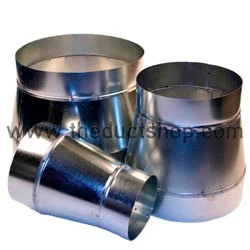Mastering Airflow: A Comprehensive Guide to HVAC Reducers
Introduction
In the world of heating, ventilation, and air conditioning (HVAC) systems, the importance of component compatibility and efficiency cannot be overstated. One such critical component is the duct reducer sometimes called a duct adapter, duct transition, duct connector, or a HVAC reducer – a seemingly small but vital part of any ductwork setup. The Duct Shop, renowned for its high-quality HVAC ducting, offers a range of reducers made from the finest galvanized steel, ensuring both durability and performance.
Understanding Reducers and Their Importance
Reducers are pivotal in duct systems, providing a smooth transition between ducts of varying sizes. They are essential in maintaining optimal airflow, preventing disruptions that can arise from abrupt size changes. At The Duct Shop, snap-lock reducers are crafted from top-tier galvanized steel, a material choice that speaks volumes about our commitment to quality and efficiency.
Installation Tips for Effective Performance
Installing these reducers is straightforward. They seamlessly slide into the adjoining ductwork and can be secured using sheet metal screws or duct tape. However, The Duct Shop advises taking an extra step – sealing the seams with a duct sealant. This small action can significantly boost the system’s efficiency, reduce air leakage, and lead to noticeable savings on utility bills.
Types of HVAC Reducers: Concentric vs Eccentric
The world of reducers is dominated by two types: concentric and eccentric. Concentric reducers, shaped like cones, align the centerlines of different-sized pipes. They are ideal for vertical applications and are commonly found on the discharge side of pumps. Eccentric reducers, with their off-center design and flat side, are perfect for horizontal installations, ensuring consistent bottom of pipe (BOP) and preventing air locks. Choosing between these depends largely on the specific requirements of your HVAC system.
Rules of Duct Design for Optimal Efficiency
Duct design is a nuanced field with several key rules. For instance, for trunk lengths up to 24 feet, a single size is sufficient. However, for longer trunks, reducing the duct size every 15 to 20 feet is advisable. These design rules, including considerations for trunk dimensions and take-off types, are crucial for maintaining efficient airflow.
Airflow Dynamics in Duct Systems
Understanding airflow dynamics is key to HVAC efficiency. As air moves through reducers, its velocity changes – it increases when moving from a larger to a smaller duct and decreases in the opposite scenario. However, the overall flow rate remains constant, a principle that underscores the importance of correct reducer selection.
Material Matters: The Superiority of Galvanized Steel
Galvanized steel, the material of choice for The Duct Shop’s reducers, offers unmatched durability and resistance to corrosion. This makes it a more reliable option compared to materials like aluminum, especially in demanding HVAC environments.
Duct Shapes and Sizes: Adapting to Diverse Requirements
The Duct Shop caters to a wide range of ducting needs with diameters from 4” to 24” for round ducting. This diversity ensures that whatever the requirements of your HVAC system, there is a reducer to fit. Because we make our reducers on site, we can create high quality custom ducting orders of both round and rectangular reducers.
Conclusion
Reducers may be small components in the grand scheme of an HVAC system, but their impact on efficiency and system performance is significant. By choosing high-quality reducers from The Duct Shop, you ensure a seamless, efficient, and reliable HVAC operation.

